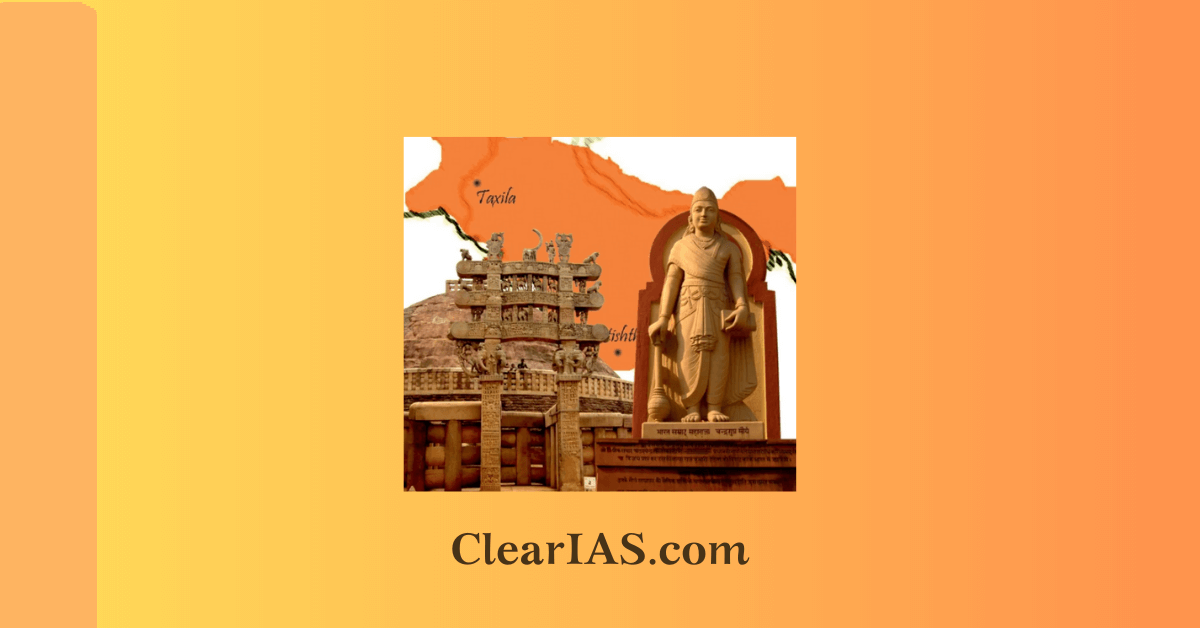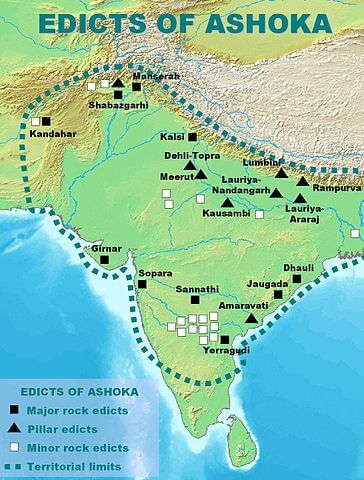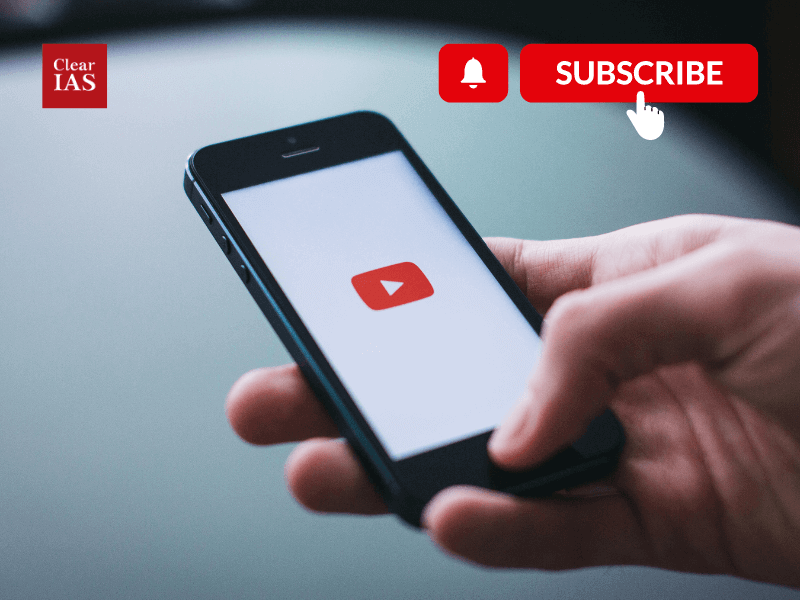
The Mauryan Empire, which existed from approximately 322 BCE to 185 BCE, was one of the first major centralized empires in ancient India. The Mauryan Empire’s influence extended over a large part of the Indian subcontinent and played a significant role in shaping the political, administrative, and cultural landscape of ancient India. Read here for a quick compilation of the Maurya and post-Maurya rulers.
NCERT texts are a must-read for every UPSC aspirant and are available for free download from ncert.nic.in website. Almost every UPSC topper has repeated the importance of reading NCERT school texts.
These are texts which help to build the fundamentals. In this article about Maurya and Post-Maurya rulers, we will be dealing with the important points filtered out from NCERT school text for Standard 6 History. We plan to cover the main points from NCERT texts for different classes and subjects in our future posts.
NCERT History Text: Standard 6
The reference material for this post is NCERT History text for Class 6 (Our past -1). Only the main points from each chapter are compiled below. Our advice is to first go through the respective NCERT text and use this compilation for quick revision. We believe that this listing will come in handy during exam time. Read further to learn about the Maurya and Post-Maurya rulers.
Maurya and Post-Maurya Rulers
- Chandragupta Maurya (322 BCE – 298 BCE): Chandragupta Maurya founded the Mauryan Empire by overthrowing the Nanda dynasty. He was guided by his mentor, Chanakya (also known as Kautilya), a renowned political strategist. Chandragupta’s reign saw the expansion of the empire, and he established an efficient administrative system.
- Bindusara (298 BCE – 273 BCE): Bindusara, the son of Chandragupta Maurya, continued his father’s expansion policies. He extended the empire’s boundaries further south into the Deccan region.
- Ashoka the Great (273 BCE – 232 BCE): Ashoka, also known as Ashoka the Great, is one of the most famous Mauryan emperors. Initially, he ruled through military conquests, but the Kalinga War in 261 BCE had a profound impact on him.
- Dasaratha Maurya (232 BCE – 224 BCE): Dasaratha was the son of Ashoka. His reign marked a period of relative stability and continuation of Ashoka’s policies.
- Samprati (224 BCE – 215 BCE): Samprati was a grandson of Ashoka and is believed to have continued Ashoka’s emphasis on Buddhism and welfare measures.
- Salisuka (215 BCE – 202 BCE): Salisuka’s rule saw the decline of the Mauryan Empire, with several provinces breaking away.
- Devavarman (202 BCE – 195 BCE): Devavarman’s reign marked a period of further disintegration of the empire.
- Shatadhanvan (195 BCE – 187 BCE): Shatadhanvan was one of the last rulers of the Mauryan Empire, and his rule saw further decline and weakening of the empire.
The Maurya and post-Maurya rulers represent a diverse range of dynasties that arose after the Mauryan decline, contributing to the rich tapestry of India’s historical and cultural heritage.
Asoka, The Emperor
- The Mauryas were a dynasty, more than 2300 years ago, with three important rulers — Chandragupta[founder], his son Bindusara, and Bindusara’s son, Ashoka.
- Chandragupta was supported by a wise man named Chanakya or Kautilya. Many of Chanakya’s ideas were written down in a book titled Arthashastra.
- Megasthenes was an ambassador who was sent to the court of Chandragupta by the Greek ruler of West Asia named Seleucus Nicator.
- Ashoka was one of the greatest rulers known to history and on his instructions inscriptions were carved on pillars, as well as on rock surfaces.
- Most of Ashoka’s inscriptions were in Prakrit and were written in the Brahmi script.
- People in different parts of the empire spoke different languages.
Ruling the empire
- As the empire was so large, different parts were ruled differently.
- The area around Pataliputra was under the direct control of the emperor. This meant that officials were appointed to collect taxes.
- Spies were kept a watch on the officials.
- Other areas or provinces were ruled by a provincial capital such as Taxila or Ujjain.
- Here Royal Princes were often sent as governors, and local customs and rules were followed.
Ashoka’s dhamma

- After Kalinga[current coastal Odisha] he gave up war.
- He started to execute Dhamma[prakrit term for Dharma]
- Ashoka’s dhamma did not involve the worship of a god or the performance of a sacrifice. He felt it his duty to instruct his subjects through the teachings of Budhha.
- He appointed officials, known as the dhamma mahamatta who went from place to place teaching people about dhamma.
- Besides, Ashoka got his messages inscribed on rocks and pillars, instructing his officials to read his message to those who could not read it themselves.
- Also sent messengers to spread ideas about dhamma to other lands, such as Syria, Egypt, Greece, and Sri Lanka.
Read: Edicts of Ashoka
Great Wall of China
- Somewhat before the time of the Mauryan empire, about 2400 years ago, began to build this wall.
- It was meant to protect the northern frontier of the empire from pastoral people.
- Additions to the wall were made over a period of 2,000 years because the frontiers of the empire kept shifting.
Vital Villages, Thriving Towns
- The use of iron began in the subcontinent around 3,000 years ago.
- The kings and kingdoms could not have existed without the support of flourishing villages.
- Some of the earliest works in Tamil, known as Sangam literature, were composed around 2300 years ago. These texts were called Sangam because they were supposed to have been composed and compiled in assemblies (known as sangams) of poets that were held in the city of Madurai.
- Jataka were stories that were probably composed by ordinary people, and then written down and preserved by Buddhist monks.
- We have hardly any remains of palaces, markets, or homes of ordinary people. Perhaps some are yet to be discovered by archaeologists.
- Another way of finding out about early cities is from the accounts of sailors and travelers who visited them.
- Crafts include extremely fine pottery, known as the Northern Black Polished Ware. It is generally found in the northern part of the subcontinent, so the name. It is usually black in color and has a fine sheen.
- Many crafts persons and merchants now formed associations known as shrenis.
- These shrenis of crafts persons provided training, procuring raw materials, and distributed the finished product.
- Shrenis also served as a bank.
Traders, Kings, and Pilgrims
- Sangam poems mention the muvendar. This is a Tamil word meaning three chiefs, used for the heads of three ruling families, the Cholas, Cheras, and Pandyas. They became powerful in south India around 2300 years ago.
- Each of the three chiefs had two centers of power: one inland, and one on the coast. Of these six cities, two were very important: Puhar or Kaveripattinam, the port of the Cholas, and Madurai, the capital of the Pandyas.
- The chiefs did not collect regular taxes. Instead, they demanded and received gifts from the people.
- Around 200 years later a dynasty known as the Satavahanas became powerful in western India.
- The most important ruler of the Satavahanas was Gautamiputra Shri Satakarni.
- He and other Satavahana rulers were known as lords of the dakshinapatha, literally the route leading to the south.
Silk Route & Kushans
- Some people from China who went to distant lands on foot, on horseback, and on camels, carried silk with them. The paths they followed came to be known as the Silk Route.
- Some kings tried to control large portions of the route. This was because they could benefit from taxes, tributes, and gifts that were brought by traders traveling along the route. In return, they often protected the traders who passed through their kingdoms from attacks by robbers.
- The best-known of the rulers who controlled the Silk Route were the Kushanas, who ruled over central Asia and northwest India around 2000 years ago.
- Their two major centers of power were Peshawar and Mathura. Taxila was also included in their kingdom.
- During their rule, a branch of the Silk Route extended from Central Asia down to the seaports at the mouth of the river Indus, from where silk was shipped westwards to the Roman Empire.
- The Kushanas issued gold coins. These were used by traders along the Silk Route.
Spread of Buddhism
- The most famous Kushana ruler was Kanishka, who ruled around 1900 years ago.
- He organized a Buddhist council, where scholars met and discussed important matters.
- Ashvaghosha, a poet who composed a biography of the Buddha, the Buddhacharita, lived in his court. He and other Buddhist scholars began writing in Sanskrit.
- A new form of Buddhism, known as Mahayana Buddhism, now developed.
- Here it has 2 distinct features: (1) Earlier, the Buddha’s presence was shown in sculpture by using certain signs. Now statues are made. From Mathura and Taxila. (2) regarded with belief in Bodhisattvas. Earlier once they attained Enlightenment they could live in complete isolation and meditate in peace. Now they remained in the world to teach and help other people. This type of worship prevailed throughout Central Asia, China, and later in Korea and Japan.
- Traders probably halted in cave monasteries during their travels.
- The older form of Buddhism, known as Theravada Buddhism was more popular in areas like Sri Lanka, Myanmar, Thailand, and other parts of Southeast Asia including Indonesia.
- The famous Chinese Buddhist pilgrims were Fa Xian, who came to the subcontinent about 1600 years ago, Xuan Zang came around 1400 years ago and I-Qing, who came about 50 years after Xuan Zang.
Bhakti
- The worship of certain deities, which became a central feature of later Hinduism, gained in importance were the contemporaries of other religion
- Anybody, whether rich or poor, belonging to the so-called ‘high’ or ‘low’ castes, man or woman, could follow the path of Bhakti.
- The idea of Bhakti is present in the Bhagavad Gita.
- Those who followed the system of Bhakti emphasized devotion and individual worship of a god or goddess, rather than the performance of elaborate sacrifices
- Once this idea gained acceptance, artists made beautiful images of these deities.
Also read: Anglo-Afghan Wars (1839-1919)
Post-Maurya Rulers
After the decline of the Maurya Empire, several regional and dynastic powers emerged in different parts of ancient India. These post-Maurya rulers played significant roles in shaping the political landscape and cultural developments of their respective regions.
Shunga Dynasty (185-73 BCE):
- The Shunga dynasty emerged in the Magadha region after the fall of the Mauryas.
- Pushyamitra Shunga is considered the founder of the dynasty. He was a general in the Mauryan army who assassinated the last Maurya ruler.
- The Shungas ruled from their capital at Pataliputra (modern-day Patna) and are known for their patronage of Buddhism and arts.
Kanvas (73-30 BCE):
- The Kanvas succeeded the Shungas and ruled the Magadha region.
- Not much is known about their rule, and their reign is often considered a relatively obscure period in Indian history.
Satavahana Dynasty (c. 230 BCE – 220 CE):
- The Satavahanas ruled in the Deccan region and parts of South India.
- They are known for their contributions to trade and administration, as well as their patronage of Buddhism.
- The Satavahana rulers played a key role in connecting the northern and southern regions of India through their control of trade routes.
Kushan Empire (c. 1st-3rd centuries CE):
- The Kushans were a Central Asian dynasty that established their rule in parts of North India.
- The empire was known for its cultural exchange, with influences from Central Asia, Persia, and India.
- The Kushans played a significant role in promoting trade along the Silk Road.
Gupta Empire (c. 320-550 CE):
- The Gupta Empire is often considered a post-Maurya power, even though it emerged centuries later.
- The Guptas ruled a substantial part of North India and are known for their contributions to art, culture, and governance during the “Golden Age” of India.
- The Gupta period witnessed advancements in science, mathematics, and literature, and the flourishing of Hindu and Buddhist art and architecture.
Vakataka Dynasty (c. 3rd-5th centuries CE):
- The Vakatakas ruled in the Deccan region after the decline of the Satavahanas.
- The dynasty is known for its architectural achievements, with notable cave temples at Ajanta.
- The Vakatakas played a role in the cultural and religious developments of the Deccan.
Compiled by Vibin Lakshmanan








Thanks 🙂 I hope u continue with all of them. Made revising ncerts easier 🙂 thanks once again
Great work bro… If possible please share short points for other NCERTs too… 🙂 Thanks….
coooool work sir 🙂
Thanks a lot 🙂 very good initiative
Good
It’s really use full for revise
This is smart work
Tnqs.
After reading these ancient history notes , is it necessary to read ancient history by romila thapper
Hii…
Revising this notes is enough for upsc or we need to read more?
Pls suggest me something if we need to revise more.
Thanks